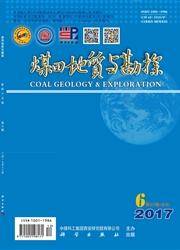

 中文摘要:
中文摘要:
贵州盘江地区是我国南方最大的煤炭工业基地之一,也是南方煤层气勘探开发的重要地区。为了揭示该区龙潭组各主力煤层聚煤环境与煤储层特征,应用煤岩学、沉积学等理论和方法,对各主力煤层的煤岩、煤质和古盐度等特征进行了分析,探讨了聚煤环境及其对主力煤层煤岩、煤质及煤储层物性的影响。结果表明,主力煤层显微组分以镜质组为主,镜惰比较高,镜惰比在垂向上呈现变小–变大–变小趋势;龙潭组下段的硫分质量分数高(>3%),而中上段硫分含量平均在1%左右。研究表明该区成煤环境可能经历了偏干燥—潮湿—偏干燥的演化过程,且降雨量充沛使成煤环境由咸化泻湖转为淡化泻湖。镜惰比和煤的灰分含量、孔隙度有较好的线性关系,说明成煤环境对煤岩、煤质及煤储层物性影响明显。
 英文摘要:
英文摘要:
Guizhou Panjiang area is not only one of the largest coal industrial bases,but also important area for coalbed methane exploration and development in south China.To reveal the main coal forming environment of Longtan Formation in Panjiang area,paleosalinity and sulfur content of main coal were studied with coal petrology and sedimentology.In addition,the influence of coal accumulating environment on the properties of coal was discussed.There are some findings:first the main coals have rich vitrinite and high V/I,the vertical change of V/I is smaller-larger-smaller;Second,sulfur content in the lower part of Longtan Formation is high(more3%),and in the upper it is1%on average.These show that the coal forming environment may have experienced partial dry-wet-partial dry evolution process,and changed from the salting lagoon to the freshing lagoon due to great amount of rainfall.The good linear relationships between ash content,porosity and V/I indicate that the coal forming environment has certain effect on the physical properties of coal reservoirs.
 同期刊论文项目
同期刊论文项目
 同项目期刊论文
同项目期刊论文
 期刊信息
期刊信息
